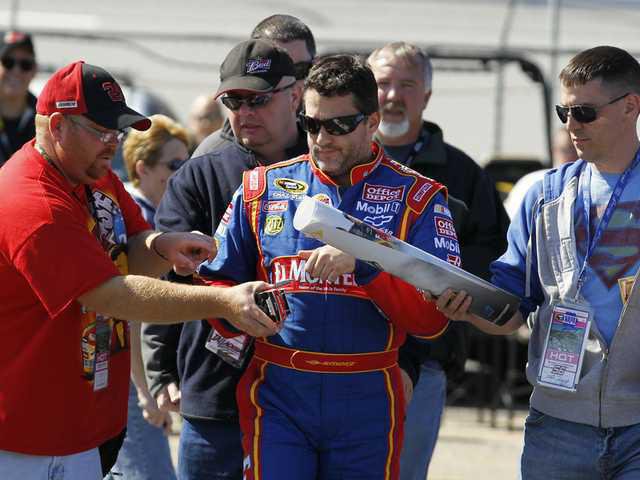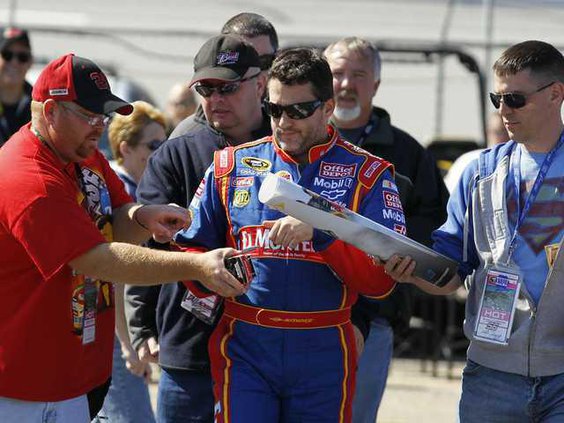TALLADEGA, Ala. — Tony Stewart competes in NASCAR. His heart, though, belongs to open-wheel racing, and he spent the first 25 years of his life trying to get to Indianapolis Motor Speedway.
When he did, in 1996, he and teammate Scott Brayton qualified first and second. Six days later, Brayton was killed during a practice run.
Stewart, a rookie that year, continued on every day at Indianapolis, started his first 500 nine days later and led 44 laps until his engine blew — finally bringing an end to what was supposed to be a celebration of him fulfilling his lifelong dream.
But that's what racers do. They race, and they'll race this weekend at Talladega Superspeedway, where NASCAR becomes the first major series to run since Dan Wheldon died Sunday in the IndyCar season finale.
"It doesn't affect us, getting back in the car," Stewart said Friday at Talladega. "We all know that can happen every week. It's been a part of racing forever.
Only some in NASCAR knew Wheldon, a popular two-time Indianapolis 500 winner who raced in a rival series. But his death touched everyone, and, 10 years after NASCAR's last fatality, brought the element of danger back to the spotlight.
NASCAR finds itself this weekend on its biggest and fastest track, where speeds can hit 200 mph and Carl Edwards' car went sailing into the fence in a 2009 last-lap accident. Debris from that accident flew into the grandstands, and seven fans were injured.
"That scared me," Edwards said of the fan injuries. "Fortunately, everybody was OK and everything worked out and all the safety stuff in place worked and went our way. But that was a little wake-up call to me that this stuff is serious, and you have to be careful."
On Friday, Greg Biffle posted the fastest lap of the two practice sessions at 198.94 mph.
Most drivers refuse to even think about the risk factor when they get into the car. But five-time defending champion Jimmie Johnson, who walked away from a nasty hit in Saturday night's race at Charlotte, admitted Wheldon's death has made drivers confront the dangers.
Johnson was one of 10 drivers who tested at Charlotte on Monday, the day after Wheldon's accident.
"Getting in the car ... deep in the back of my mind, just thinking about things and there's my marks in the wall in turn two and I'm like 'Yeah, I had a bad angle and I hit pretty hard,'" Johnson said. "I think we spend very little time as drivers thinking about it, right or wrong. It's just kind of who we are."
NASCAR has made significant upgrades in safety since Dale Earnhardt's 2001 fatal accident, from SAFER barriers, an updated car, the mandatory use of head-and-neck restraints and stronger seats. IndyCar also has made up considerable ground in safety, but Sunday's race was the final event for its current car. The new car scheduled to debut next season is considered to be a vast improvement in safety and technology standards.
Even so, former Formula One world champion Jody Scheckter wants his son, Tomas, to quit the IndyCar series.
"I've wanted him to give up for a while," Scheckter told BBC. "Hopefully this will knock some sense into him and make him realize there is more to life. It really isn't worth it. It is the most dangerous form of motor racing at the moment."
IndyCar was at Las Vegas for the first time since 2000, and the first time since the track was reconfigured to add progressive banking. Many have complained the combination of the banking and the current car were an unsuitable mix Sunday, but the series' top drivers have remained largely silent on the issue since Wheldon's accident.
IndyCar CEO Randy Bernard has called a driver meeting for Monday, the day after the second of two scheduled memorials.
"It's very easy for you to blame things after it happens, and not before," said Nelson Piquet Jr., a former Formula 1 driver who now races in NASCAR's Trucks Series. He was watching his father race in 1994 when Ayrton Senna was killed, F1's last fatality.
"Before, nobody says anything, and when the accident happens everyone starts getting revolted and everybody starts complaining."
Stewart, the 1997 IndyCar series champion, staunchly defended the series Friday and urged people "to take a deep breath and let the emotions settle down."
"You hate it for everybody involved. Randy Bernard has been getting beat up over it, and he shouldn't. It's part of racing, its part of what can happen," Stewart said. "It still boils down to the people that are steering the cars around. It's not that the cars are unsafe; there's still people that tell the cars where to go, so we've got to take responsibility.
"There is no reason for anybody to point fault anywhere. There's no fault in it. It's racing. It's a freak thing that happened, and it can happen every race."
NASCAR president Mike Helton does not view Wheldon's accident as an IndyCar problem, but one that affects every form of motorsports and forces everyone to push to make racing as safe as possible.
"Sunday is one of those moments where all those billions of hours that have gone into safety make you remember it's still a dangerous sport," Helton said. "It's safer than it's ever been, but no matter how hard you work, circumstances can line up to create a really tough situation. When that happens, it transcends to every sanctioning body in existence."
And even though Kyle Busch used words such as "inevitable" to describe Wheldon's death and spoke of the constant "threat that something horrifying can happen," drivers believe they are safe.
"I feel good about where our sport is and the safety procedures and precautions and everything that NASCAR has continuously developed through the years," Kevin Harvick said. "I think when you look at IndyCar racing, in particular and you look at the style of cars that they race and don't get me wrong ... they have a constant effort to be a part of the safety precautions and safety measures ... the bottom line is, those cars are running really fast and your head is hanging out of the cockpit and some things are going to happen.
"It is part of our business."
NASCAR remembers Wheldon as it prepares to race





